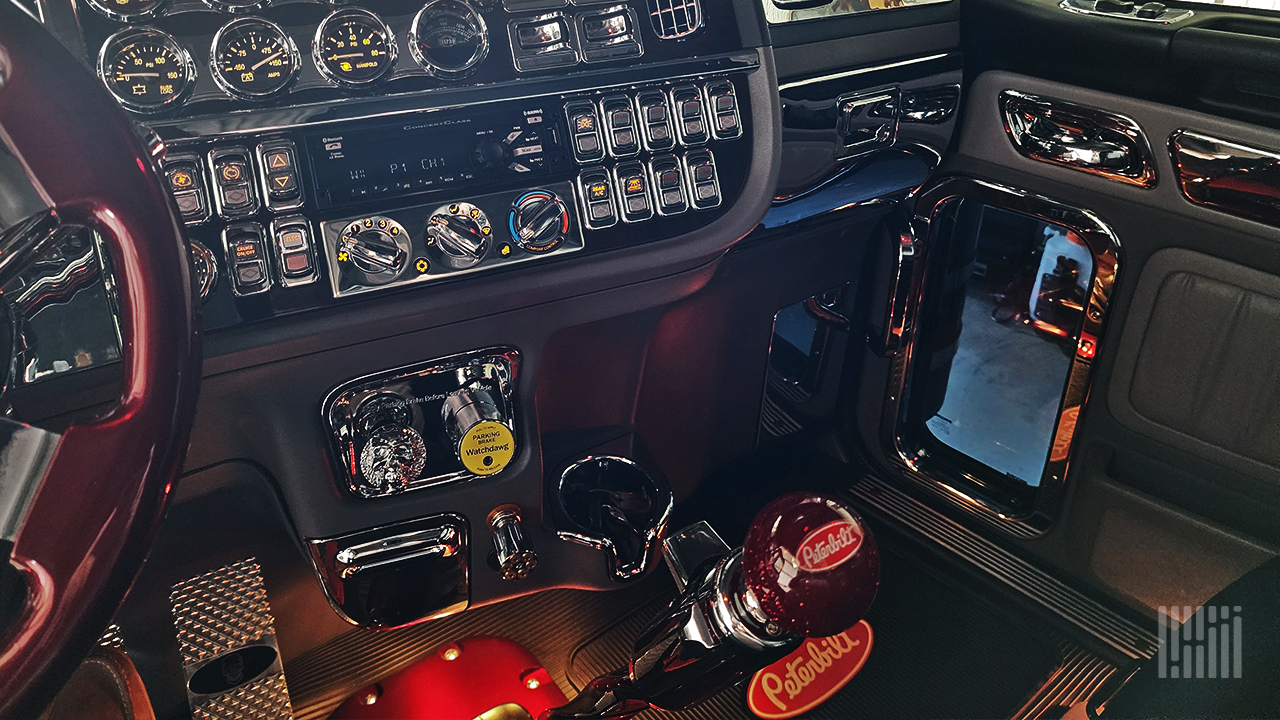
From Intimidation to Integration
Old-school truckers remember when commercial vehicles came with separate transmissions that required two gear shift levers. These were genuinely intimidating to newcomers. Operating a twin-stick setup demanded precise timing between the main transmission and auxiliary transmission, deep mechanical understanding of how power flowed through the drivetrain, physical coordination that took months to master, and mental bandwidth that left little room for distraction.
The learning curve was steep enough that many potential drivers took one look and walked away. But those who persisted gained something valuable: an intuitive understanding of how trucks actually worked. They learned why you couldn’t force a gear, how engine braking worked with the transmission, and what it meant when something didn’t sound right coming from the drivetrain.
The industry’s move to single-lever transmissions in the 1980s and 1990s represented the first major simplification. Suddenly, you only needed to master one shifter, though the underlying skills remained demanding. Drivers still had to perfect double-clutching technique for smooth shifts, understand RPM matching between engine and transmission speeds, grasp gear ratios and their relationship to load and terrain, and maintain mechanical sympathy for the equipment.
This era produced drivers who could diagnose transmission problems by sound, knew exactly when to downshift for a grade, and understood the relationship between gear selection and fuel economy. The barrier to entry dropped, but competence requirements remained high. These drivers developed an almost telepathic connection with their equipment, sensing problems before they became failures and optimizing performance through skill rather than computer algorithms.
The numbers tell the story of how quickly the industry transformed in the 2000s and beyond. In 2005, over 95% of trucks still had manual transmissions, with early AMT adoption just beginning. By 2010, automatic transmissions had captured 20-25% of the market as fleets began to recognize the fuel efficiency benefits. The surge came between 2014 and 2017, with AMT adoption jumping from 25-70% depending on manufacturer to a 50/50 split across the industry. By 2018-2019, major OEMs reported 75-80% AMT take-rates, and today that figure has reached 90+% for new builds, with manuals mostly relegated to vocational applications.
This was a fundamental shift in what trucking required from its workforce. The mechanical knowledge that once defined professional drivers became optional, then irrelevant, then forgotten.
Cognitive Transformation
Driving a manual transmission truck was about constant cognitive engagement. Drivers continuously calculated engine speed, road speed, load weight, grade, and traffic conditions to determine optimal shift points. Both hands and feet were actively involved in the driving process, leaving less capacity for secondary tasks. Understanding why you couldn’t force a gear, why floating gears required precise timing, and how transmission temperature affected shifting created deeper vehicle knowledge that extended far beyond just operating the truck.
In city traffic, on mountains, or in challenging conditions, manual transmissions require complete attention to driving dynamics. There was no autopilot mode, no set-it-and-forget-it operation. Every mile required active participation in managing the machine, creating a level of situational awareness that many veterans argue is missing from modern driving.
AMTs fundamentally changed these cognitive demands. Push a button, select drive, and the computer handles shift timing, engine protection, and fuel optimization. Without gear management responsibilities, drivers have more cognitive bandwidth for other activities, but they also lose the mechanical connection that once kept them intimately involved with vehicle operation. The computer makes thousands of decisions that drivers once made instinctively, removing both the burden and the education that came with manual operation.
This transformation freed mental capacity that could be directed toward safety and efficiency, but it also created opportunities for distraction that simply didn’t exist when both hands and full attention were required for basic vehicle operation. The question becomes whether this trade-off improved or degraded overall driving performance.
The Barrier-to-Entry Revolution
Manual transmissions created a natural selection process that the industry didn’t fully appreciate until it was gone. The intimidation factor alone deterred many potential drivers who were overwhelmed by the perceived complexity of learning to shift correctly. Those who persisted had to develop genuine competence before becoming productive, creating a workforce that was filtered not just by interest but by ability to master complex mechanical skills.
The learning process taught drivers about truck systems in ways that no classroom instruction could match. Understanding how to float gears required grasping the relationship between engine RPM, transmission input shaft speed, and gear ratios. Learning to downshift properly meant understanding engine braking, weight distribution, and the physics of momentum. These weren’t abstract concepts but practical skills that had immediate consequences if performed incorrectly.
The commitment level required to master manual shifting meant drivers were more likely to stay in the industry once they’d invested the time to become competent. There was a sunk cost in education that created loyalty and professional identity. Drivers who conquered the twin-stick or mastered the 18-speed felt they’d earned their place in the profession through skill development rather than just completing a training program.
Automatic transmissions democratized commercial driving by creating a broader labor pool, enabling faster training, lowering the intimidation factor, and making careers accessible to drivers with physical limitations. Anyone comfortable driving a car could theoretically operate a truck, reducing CDL school time and creating quicker transitions to productivity.
This accessibility came with trade-offs that the industry is still processing. The natural filter that once separated serious candidates from casual interest disappeared, potentially changing not just who enters trucking but who stays and how they approach the profession.
The Distraction Equation
The cognitive demands of manual transmission driving created built-in distraction resistance that many didn’t recognize until it was gone. Hands and mind were continuously occupied with driving tasks, creating immediate consequences for poor attention to shifting and physical constraints that limited the ability to multitask while managing clutch and shifter. Gear selection required continuous assessment of driving conditions, maintaining a level of situational awareness that extended beyond just steering and speed control.
AMTs removed many of these natural constraints. Free hands mean availability for other activities, reduced vigilance requirements allow mental wandering, and the physical and mental capacity once devoted to transmission management becomes available for secondary tasks. The immediate mechanical feedback that punished inattention to driving dynamics disappeared, replaced by computer systems that compensate for driver errors without necessarily alerting the driver to their mistakes.
This freedom has undeniable benefits, reduced fatigue, improved fuel economy through optimized shifting, and the ability to focus on traffic and road conditions rather than mechanical operations. But it also created opportunities for distracted driving behaviors that were physically impossible with manual transmissions. The industry hasn’t fully grappled with whether this increased capacity for distraction has contributed to changing crash patterns or driver behavior.
Veterans argue that the constant engagement required by manual transmissions created better drivers, not just because of the mechanical skills they developed, but because of the attention habits they formed. When every shift requires active participation, drivers develop patterns of continuous situational assessment that extend beyond transmission operation to overall vehicle management and road awareness.
The Competence Question
The shift to automatics coincided with a broader decline in mechanical knowledge among drivers that extends far beyond just transmission operation. Fewer drivers understand how the engine, transmission, and differential work together as integrated systems. The era of drivers who could change oil, adjust brakes, or diagnose problems is essentially over, replaced by operators who view trucks as appliances rather than complex mechanical systems requiring understanding and respect.
This knowledge gap has created new challenges for fleets. Maintenance dependence has increased as drivers become less capable of identifying developing problems or performing basic roadside repairs. Equipment abuse has become more common as reduced mechanical sympathy leads to operation beyond design limits without recognition of the consequences. Training programs now focus heavily on regulations and compliance while spending less time on vehicle systems and mechanical principles.
The loss is about professional identity and the relationship with the equipment. Drivers who understood their trucks developed a respect for mechanical limits, an appreciation for proper maintenance, and a pride in operating complex machinery skillfully. Modern drivers may view trucks as tools for completing transportation tasks rather than as sophisticated machines that require mastery and care.
This transformation raises fundamental questions about what constitutes professional competence in commercial driving. Should mechanical knowledge remain a professional requirement even as technology eliminates the practical need for such understanding? How much should drivers know about the systems they operate, and what are the safety and efficiency implications of reduced mechanical literacy?
Safety Considerations
AMTs present both safety benefits and concerns that the industry is still evaluating. Potential benefits include reduced driver fatigue from the elimination of clutching, consistent shift timing regardless of driver skill level, engine protection features that prevent over-revving, and improved fuel economy through computer-optimized shifting patterns. These improvements can enhance safety by reducing physical stress, preventing mechanical failures, and optimizing vehicle performance beyond what most drivers could achieve manually.
Potential concerns include increased capacity for distracted driving behaviors, reduced situational awareness of vehicle dynamics, less mechanical connection to vehicle performance, and potential overconfidence in vehicle capabilities. The industry lacks comprehensive data on whether transmission type correlates with crash rates, though anecdotal evidence suggests some troubling trends.
The freedom that AMTs provide for secondary tasks has coincided with increased use of mobile devices, mobile computing systems, and other in-cab technologies that compete for driver attention. While correlation doesn’t prove causation, the timing of increased distraction-related incidents with AMT adoption raises questions about whether easier vehicle operation has enabled behaviors that contribute to crashes.
More subtly, the reduced mechanical awareness that comes with AMT operation may affect emergency response capabilities. Drivers who don’t understand engine braking, gear selection for specific conditions, or the relationship between transmission operation and vehicle control may be less prepared to handle equipment failures or extreme driving situations that require manual intervention.
The Cultural Shift
The transmission transition reflects broader changes in trucking culture that extend far beyond mechanical operation. Traditional drivers took pride in mechanical knowledge and shifting skill, maintaining self-reliance for basic maintenance and repairs while developing a deep understanding of equipment limitations and respect for the complexity of commercial driving. This created a professional identity built around mastery of difficult skills and intimate knowledge of complex machinery.
Modern drivers are more technology-focused than mechanically focused, dependent on fleet maintenance support, and prioritize regulatory compliance over mechanical knowledge. They may view trucking more as a transportation service than as a skilled trade, changing the profession’s identity from mechanical mastery to logistics execution.
This cultural shift raises questions about the professional identity and future direction of trucking. Has trucking evolved from a skilled trade requiring years to master into a logistics function that can be learned in weeks? Should mechanical competence remain a professional requirement, and how much vehicle knowledge should modern drivers possess? Does reduced complexity affect long-term career development and professional satisfaction?
The answers aren’t clear, but the transformation is undeniable. The generation of drivers who learned to drive on manual transmissions is retiring, taking with them institutional knowledge and professional attitudes that may not be transferable to drivers who learned on automatics. Whether this represents progress or loss depends on how you define professional competence and what you believe trucking should require from its practitioners.
Industry Implications and the Road Ahead
Fleet managers report significant operational benefits from AMT adoption, including expanded candidate pools, reduced training barriers, improved fuel economy, reduced maintenance costs, and increased productivity through faster driver training and reduced fatigue. These advantages are compelling and have driven the widespread adoption that makes AMT prevalence irreversible.
Yet, some managers express concerns about driver quality, mechanical knowledge, technology dependency, and the preservation of long-term skills. The industry faces the challenge of balancing accessibility with competence, maintaining trucking’s identity as a skilled profession while embracing technological advancements, and ensuring that easier operations do not compromise safety standards or professional development.
The transmission transition is largely complete, but its lessons become more relevant as trucking continues evolving toward greater automation. Each technological simplification changes who can do the job and how they do it. Autonomous vehicles, electric powertrains, and advanced driver assistance systems will further transform what professional driving requires and who it attracts.
The question isn’t whether AMTs are good or bad, they’re clearly here to stay and offer undeniable benefits. The question is whether the industry recognizes what it’s gained and lost in the transition and how to preserve the positive aspects of driver competence and engagement while embracing technological progress.
What We’ve Gained and Lost
The transition from manual to automatic transmissions represents a fundamental transformation of what the profession requires and who it attracts. The benefits are undeniable: improved efficiency, reduced physical demands, expanded accessibility, and enhanced performance optimization. AMTs have made trucking more inclusive and, in many measurable ways, more efficient.
That transition also eliminated what may have been an important natural filter, creating competent, engaged, mechanically aware drivers who viewed trucking as a skilled profession requiring mastery, rather than a transportation job requiring compliance. Manual transmissions required commitment, created mechanical knowledge, demanded constant attention, and produced drivers who understood their equipment and respected its limitations.
The great transmission shift is complete. Now comes the harder task of figuring out what it all means for the future of professional driving, and whether the industry can maintain the competence, professionalism, and safety culture that made trucking work while embracing the technological advancement that makes it more efficient and accessible.
The debate continues in fleet break rooms, truck stops, and industry conferences nationwide. What’s clear is that trucking today is fundamentally different from trucking twenty years ago, and the transmission transition played a central role in that transformation. Whether that change represents progress or loss may depend on what you believe professional driving should require and who it should serve.



